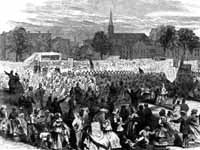Conflict of Abolition and Slavery

|
This map compares statistics on free and slave states.
Issued during the presidential election campaign of 1856, it pictures
famous Western explorer John C. Fremont (1813-1890), the first
presidential candidate of the Republican Party, and his running
mate, William L. Dayton (1807-1864). The Republican Party had been
created in 1854 by opponents of the Kansas-Nebraska Bill, which
allowed for extension of slavery into free territory in the West.
Despite gaining thirty-three percent of the popular vote, Frémont
lost the election to James Buchanan (1791-1868). Four years later,
however, the Republican Party succeeded in electing Abraham Lincoln
(1809-1865).
Reynolds Political Map of the United States, designed to
exhibit the comparative Area of the free and slave states New
York and Chicago, 1856 Map Geography
and Map Division (56)
|

|
This map, entitled Historical Geography, portrays
American history as a conflict between two opposing trees struggling
to dominate the land. One was the tree of slavery, planted at Jamestown,
Virginia, in 1619; the other, planted by the Pilgrims at Plymouth
in 1620, was the tree of liberty. The text at the bottom of the
map explains the allegory and associates the Republican Party with
the liberty tree.
Historical Geography, by John F. Smith Chicago,
1888 Map Geography
and Map Division (57)
|

|
William Lloyd Garrison (1805-1879) issued the first
number of The Liberator on January 1, 1831. The radical
tone of the paper was unprecedented because it labeled slave-holding
a crime and called for immediate abolition. When the Nat Turner
rebellion of August 1831 escalated Southern fears of slave uprisings,
some Southern states passed laws making circulation of The Liberator
a crime and called for prosecution of Garrison. Although he had
detractors, Garrison quickly became a noted leader of the anti-
slavery movement and helped launch the American Anti-Slavery Society
in Philadelphia in 1833. Until he ceased publication in 1865, Garrison
employed the Liberator to advance militant anti- slavery views.
He especially opposed African colonization, as is shown in the
article entitled "Emigration" in column one of this issue.
The Liberator, May 21, 1831, p. 1 Newspaper Rare
Book and Special Collections Division (59)
|

|
Beginning in the 1840s, abolitionist societies used
songs to stir up enthusiasm at their meetings. To make the songs
easier to learn, new words were often set to familiar tunes. This
1841 song by William Lloyd Garrison has six stanzas set to the
tune of "Auld Lang Syne."
"Song of the Abolitionist," 1841 William Lloyd Garrison, Author
Holograph Manuscript Division (60)
|

|
On April 19, 1866, the African-American citizens
of Washington, D.C., celebrated the abolition of slavery. A procession
of 4,000 to 5,000 people assembled at the White House, where they
were addressed by President Andrew Johnson (1808-1875). Marching
past 10,000 cheering spectators, the procession, led by two black
regiments, proceeded up Pennsylvania Avenue to Franklin Square
for religious services and speeches by prominent politicians. A
sign on top of the speaker's platform read: "We have received our
civil rights. Give us the right of suffrage and the work is done."
"Celebration of the abolition of slavery in the District of Columbia
by the colored people in Washington, April 19, 1866," From Harper's
Weekly, May 12, 1866, p. 300 Photomural from woodcut Prints
and Photographs Division (62)
|

|
John Brown (1800-1859) was an abolitionist who took
direct action to free slaves by force. Following his raid on the
arsenal at Harpers Ferry, in mid-October 1859, he was convicted
of treason, conspiracy, and murder. One of the most controversial
abolitionists, Brown was regarded by some as a martyr and by others
as a common assassin. Brown's dignified bearing in prison and at
his trial moved many spectators. Ralph Waldo Emerson said that
Brown's death would "make the gallows as glorious as the cross." This
image shows a heroic Brown being adored by a slave mother and child
as he walks to his execution on December 2, 1859.
John Brown, The Martyr New York: Currier and Ives,
1870 Prints and Photographs
Division (127) |
|